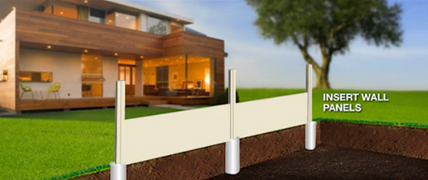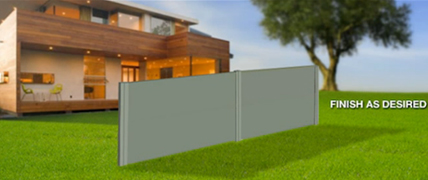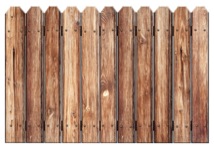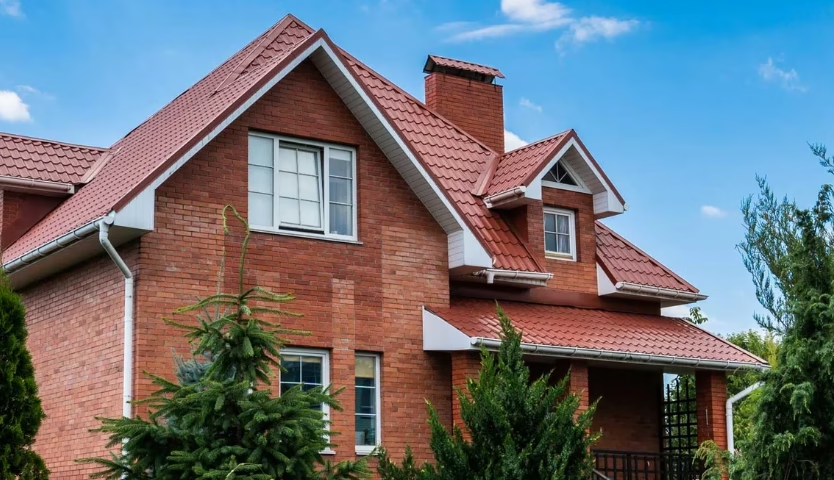In this article we summarise the typical construction method of back yard fencing including traditional timber paling, tubular fencing and rendered “look-a-like” panel fencing. The building of a fence, no matter what type, is similar in construction and not difficult; it just takes a little planning & preparation.
By-the-way: rendered brick fences will be covered in a future article as they are not for suitable for DIY. By comparison they are very expensive to build – requiring the skills of a professional bricklayer, concreter, renderer and painter – and taking many weeks to construct.
So what’s involved?
The following information includes the typical steps that fencing professionals use to construct a fence.
Step 1. Do your research
It is important to understand everything there is to know about your yard before you start preparing for your new fence.
(1) Call “Dial Before You Dig” to check for service line locations. This service can tell you over the phone if there are any services in the area you are planning to have your fence.
(2) Call your local council and tell them about your fence plans. Ask their advice on your proposed fence. Most side boundary fences can be up to 1800mm high with an extra 400mm privacy screening on top (2200mm high in total), but check with your local council
(3) Know where your boundary lines are. It is surprising how many existing fences do not run along boundary lines. You may have a site plan in your files that will provide this information; otherwise you may need to engage a surveyor to confirm the exact location of your boundary lines.
(4) Choose materials that will achieve your requirements. For example, your fence may need to:
- Match your home and look neat, classy and modern
- Comply with pool fencing requirements
- Be cheap and affordable
- Block out traffic noise and have excellent acoustic properties
- Look like an expensive, modern rendered brick fence, without the cost
- Disappear into the landscape (black tubular fencing is perfect. It absorbs light and visually disappears if plantings are close).
- Be low maintenance and simple in design.
Step 2. Get your tools and materials
The list below lists the tools and materials you will need to build your fence.
|
|
Step 3. Setting up
Once you know where your boundary lines are you can start preparing the ground.
(1) Clear the area
Clear the area of all vegetation and anything else in the path of the new fence (tree roots included). This boundary is now ready for marking.
(2) Mark the boundary line
The boundary line needs to be marked to ensure the new fence is not built outside the boundary line, and is providing your property with the most amount of usable space possible. It is advisable to have the boundary line marked by a professional surveyor (many neighbourhood arguments start over boundary fences).
(3) String Line
Once the boundary lines are located you can then install the “string line” for the new fence. Mark a line that runs parallel to the boundary line 50mm inside the boundary by marking out your fence with two stakes, some string and spray paint.
- Hammer the first stake into the ground at the start your new fence
- Then tie the string to the stake and walk the string down to the location of where the fence is to end, hammer in the second stake. Ensure you measure 50mm of the boundary line before you hammer the stakes into the ground. This “string line” is now providing a straight line for your fencing to be built against
- Level out the ground again along the string line and around
- Push the string down the stakes until it is close to ground level. Spray paint on this string line up the entire length of the string. Move the string back up the stakes about 300mm. The spray line & string line will act as guides throughout your fence build
(4) Setting out the post holes
Once the ground is level (without holes or lumps) lightly compressed the soil using your boots and walk around a little. You are now ready to set-out your posts.
Measure the length of the allocated fence space and divide this length by about 1600mm lengths. Mark the junction of each 1600mm length with spray paint line that will intersect with the fence line spray mark you have made previously.
We have suggested 1600mm centre spacings for posts as most timber rail lengths come in 4800mm lengths (4800/3 = 1600). You can have the posts up to 2400mm apart, but this would depend on the wind loading in your area (talk to council & your hardware store).
Step 4. Quantities and materials
Calculate the quantities of materials that will be required based on your fence type, measurements and calculations above.
 Dig post holes in the right place to the recommended depth. Heavy machinery is not required.
Dig post holes in the right place to the recommended depth. Heavy machinery is not required. Place posts into the holes (they are manufactured to replicate the dimensions of traditional columns) and pour concrete, ensuring posts are plumb and straight.
Place posts into the holes (they are manufactured to replicate the dimensions of traditional columns) and pour concrete, ensuring posts are plumb and straight.
 Install the panels.
Install the panels.
 Finish as desired – with acrylic paint, texture paint, acrylic render finish and even stone cladding to seamlessly match the overall look and feel of the home or landscaping project.
Finish as desired – with acrylic paint, texture paint, acrylic render finish and even stone cladding to seamlessly match the overall look and feel of the home or landscaping project.
Step 5. Get dirty!
(1) Digging post holes
Whether you are installing a traditional ‘Lapped and Capped’ fence, timber paling fence, tubular fence or a modern modular type fence the principals are the same, you start construction by digging the post holes.
Dig a post hole for each post. This is typically 400x400mm wide and 600mm deep, depending on the size of the post.
(2) Installing the posts
Ensure you have your posts cut-to-size and ready to go with a spirit level handy. During this stage you need to be ready and work quickly before the concrete firms and “goes off”.
Put the first post down into the centre of the first hole. Hold the post upright and empty the dry concrete mix straight into the hole filling 3/4 of the hole. Add water to manufactures instructions – normally about 1/3 water to 2/3s dry mix. Mix the concrete in the hole with a spade or a concrete mixer till combined.
When the concrete becomes firm enough to not require holding (but not too firm), use your spirit level to check the straightness for your posts. This part is really important. All the posts need to be as straight as possible and running in a straight line with all the other posts. Hold the Spirit level vertically and rest against all 4 sides of the timber post, ensure each side of the post sees the ‘level bubble’ at the mid-way point. If the bubble is not in the mid-way point tap the post lightly with a hammer or mallet, or move with hands until the bubble is in the mid-way area on all four sides of your post.
Installing the posts is the most difficult part, after that it’s a bit like building with Lego, just heavier.
(3) Installing the rails
As most fencing posts come already prepared for rails (or in the case of tubular or panel fencing – panels) installing the rails is easy (although the timber rail ends may need to be trimmed to ensure they fit neatly between the posts).
The rails will need to be diagonally nailed three to four times to secure them in place.
In the case of tubular and panel fencing systems once the panels are installed the job is basically finished. Panel fencing systems like the Slim wall product only need a coat of paint (smooth acrylic paint or with a sand texture added for the fencing to look like a solid rendered brick wall.
(4) Cladding
Your fence is now almost ready to clad, but we still need a string line installed on top and between the posts to act as a guide – to ensure palings run in a neat line. Hammer a nail into the tops of all the posts and tie string line between these nails – pull firm and tie-off the string.
You are now ready to add the timber palings. This is where the nail gun really helps. You will need to nail the timber paling into the railings 4 times. Hand nailing into hardwood timber is slow going. Nail the first nail through the first paling into the top rail – making sure the top of the paling is lining up with the string line. Place your spirit level vertically on both sides of the paling to ensure the paling is straight. Hold the paling in place and nail the second nail to the bottom rail, this will secure the paling for the third and fourth nails that are to be place next to nails one and two.
Now that you have your first perfectly straight paling in place, this paling will act as a guide for all the other palings.
Final notes
There are many types of boundary fences that are easy to install. By following the four steps above you too can add another DIY job to your belt and save dollars in the process.







